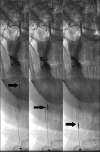Intravascular ultrasound: principles and cerebrovascular applications
- PMID: 20133387
- PMCID: PMC7964240
- DOI: 10.3174/ajnr.A1810
Intravascular ultrasound: principles and cerebrovascular applications
Abstract
Intravascular sonography is a valuable tool for the morphologic assessment of coronary atherosclerosis and the effect of pharmacologic and nonpharmacologic interventions on the progression or stabilization of atherosclerosis. An analysis of the different modes, applications, and limitations is provided on the basis of review of existing data from multiple clinical case studies, trials, and mechanistic studies. Intravascular sonography has been used to assess the outcomes of different percutaneous interventions, including angioplasty and stent implantation, and to provide detailed characterization of atherosclerotic lesions, aneurysms, and dissections within the cerebrovascular circulation. Evolution of intravascular sonographic technology has led to the development of more sophisticated diagnostic tools such as color-flow, virtual histology, and integrated backscatter intravascular sonography. The technologic advancement in intravascular sonography has the potential of providing more accurate information prior, during, and after a medical or endovascular intervention. Continued assessment of this diagnostic technique in both the intracranial and extracranial circulation will lead to increased use in clinical practice with the intent to improve outcomes.
Figures




Similar articles
-
Applications of intravascular ultrasound in the treatment of peripheral occlusive disease.Semin Vasc Surg. 2006 Sep;19(3):139-44. doi: 10.1053/j.semvascsurg.2006.06.004. Semin Vasc Surg. 2006. PMID: 16996415 Review.
-
Virtual histology and color flow intravascular ultrasound in peripheral interventions.Semin Vasc Surg. 2006 Sep;19(3):155-62. doi: 10.1053/j.semvascsurg.2006.06.001. Semin Vasc Surg. 2006. PMID: 16996418 Review.
-
Angiographic and three-dimensional intravascular ultrasound analysis of combined intracoronary beta radiation and self-expanding stent implantation in human coronary arteries.Am J Cardiol. 2004 Nov 15;94(10):1237-42. doi: 10.1016/j.amjcard.2004.07.106. Am J Cardiol. 2004. PMID: 15541237 Clinical Trial.
-
Virtual histology-intravascular ultrasound assessment of lesion coverage after angiographically-guided stent implantation in patients with ST Elevation myocardial infarction undergoing primary percutaneous coronary intervention.Am J Cardiol. 2012 May 15;109(10):1405-10. doi: 10.1016/j.amjcard.2012.01.348. Epub 2012 Feb 28. Am J Cardiol. 2012. PMID: 22381156
-
[Transcranial color-coded Doppler sonography: getting started].Neurol Neurochir Pol. 2001;35 Suppl 5:101-9. Neurol Neurochir Pol. 2001. PMID: 11935669 Review. Polish.
Cited by
-
Off-label use of drugs and devices in the neuroendovascular suite.AJNR Am J Neuroradiol. 2013 Nov-Dec;34(11):2054-63. doi: 10.3174/ajnr.A3447. Epub 2013 Mar 21. AJNR Am J Neuroradiol. 2013. PMID: 23518356 Free PMC article. Review.
-
Intracranial-derived atherosclerosis assessment: an in vitro comparison between virtual histology by intravascular ultrasonography, 7T MRI, and histopathologic findings.AJNR Am J Neuroradiol. 2013 Dec;34(12):2259-64. doi: 10.3174/ajnr.A3631. Epub 2013 Jun 27. AJNR Am J Neuroradiol. 2013. PMID: 23811977 Free PMC article.
-
Effect of Intravascular Ultrasound-assisted Thoracic Endovascular Aortic Repair for "Complicated" Type B Aortic Dissection.Chin Med J (Engl). 2015 Sep 5;128(17):2322-9. doi: 10.4103/0366-6999.163386. Chin Med J (Engl). 2015. PMID: 26315080 Free PMC article.
-
Intracranial Atherosclerotic Stenoses: Pathophysiology, Epidemiology, Risk Factors and Current Therapy Options.Adv Ther. 2020 May;37(5):1829-1865. doi: 10.1007/s12325-020-01291-4. Epub 2020 Apr 8. Adv Ther. 2020. PMID: 32270364 Free PMC article. Review.
-
The Effect of Lesion Length on Doppler Velocities Used Routinely to Determine Carotid Stenosis Cross-Sectional Severity.Diagnostics (Basel). 2025 May 15;15(10):1259. doi: 10.3390/diagnostics15101259. Diagnostics (Basel). 2025. PMID: 40428257 Free PMC article.
References
-
- Nissen SE, Tuzcu EM, Schoenhagen P, et al. . Effect of intensive compared with moderate lipid-lowering therapy on progression of coronary atherosclerosis: a randomized controlled trial. JAMA 2004; 291: 1071–80 - PubMed
-
- Guedes A, Tardif JC.. Intravascular ultrasound assessment of atherosclerosis. Curr Atheroscler Rep 2004; 6: 219–24 - PubMed
-
- Waller BF, Pinkerton CA, Slack JD. Intravascular ultrasound: a histological study of vessels during life—the new “gold standard” for vascular imaging. Circulation 1992; 85: 2305–10 - PubMed
-
- Lockwood GR, Ryan LK, Gotlieb AI, et al. . In vitro high resolution intravascular imaging in muscular and elastic arteries. J Am Coll Cardiol 1992; 20: 153–60 - PubMed
-
- Gatzoulis L, Watson RJ, Jordan LB, et al. . Three-dimensional forward-viewing intravascular ultrasound imaging of human arteries in vitro. Ultrasound Med Biol 2001: 27: 969–82 - PubMed
Publication types
MeSH terms
LinkOut - more resources
Full Text Sources
Other Literature Sources
